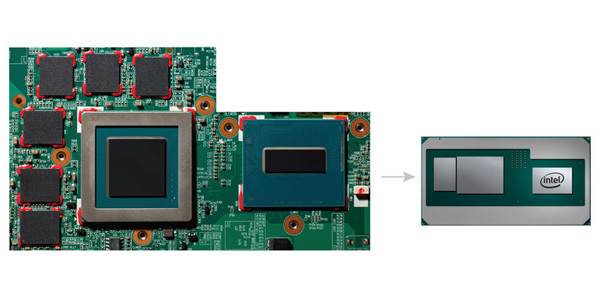With Custom Discrete Graphics From AMD to Enable Sleeker, Thinner Devices
We often talk about our focus on driving innovation for the enthusiast community, a targeted but growing segment of the PC market.
This point is underscored by what we have been delivering with our Intel Core X-series processors, Intel Core H-series mobile processors and, more recently, the first of our 8th Gen Intel Core desktop processors.
Each product line offers a range of new capabilities, workloads and form factors to cater to the diverse needs of enthusiasts.
But as we looked at this lineup, we recognized an opportunity: thinner, lighter, more powerful enthusiast mobile platforms that deliver a premium experience.
Currently, most enthusiast mobile PCs have Intel Core H-series processors plus higher-powered discrete graphics, resulting in systems that average 26 mm in height. Compare this to thin and light laptops that are trending down to 16 mm or less, with some even as thin as 11 mm.
We wanted to find a way to improve this. A way to deliver a stronger combination of performance-level processors and discrete graphics that open the door to even smaller form factors. And, we knew we could do it by combining our Embedded Multi-Die Interconnect Bridge(EMIB) technology with a new power-sharing framework.
Today, we're sharing initial details on a new product that does exactly that, reducing the usual silicon footprint to less than half that of standard discrete components on a motherboard.
That's more freedom for OEMs to be creative and deliver innovative thin and light designs with improved thermal dissipation. It also delivers space to add new features, create new board layouts, explore new cooling solutions or increase battery life.
The new product, which will be part of our 8th Gen Intel Core family, brings together our high-performing Intel Core H-series processor, second generation High Bandwidth Memory(HBM2) and a custom-to-Intel third-party discrete graphics chip from AMD's Radeon Technologies Group – all in a single processor package.

It's a prime example of hardware and software innovations intersecting to create something amazing that fills a unique market gap. Helping to deliver on our vision for this new class of product, we worked with the team at AMD's Radeon Technologies Group.
In close collaboration, we designed a new semi-custom graphics chip, which means this is also a great example of how we can compete and work together, ultimately delivering innovation that is good for consumers.
“Our collaboration with Intel expands the installed base for AMD Radeon GPUs and brings to market a differentiated solution for high-performance graphics,” said Scott Herkelman, vice president and general manager, AMD Radeon Technologies Group.
“Together we are offering gamers and content creators the opportunity to have a thinner-and-lighter PC capable of delivering discrete performance-tier graphics experiences in AAA games and content creation applications.
This new semi-custom GPU puts the performance and capabilities of Radeon graphics into the hands of an expanded set of enthusiasts who want the best visual experience possible.”
At the heart of this new design is EMIB, a small intelligent bridge that allows heterogeneous silicon to quickly pass information in extremely close proximity.
EMIB eliminates height impact as well as manufacturing and design complexities, enabling faster, more powerful and more efficient products in smaller sizes. This is the first consumer product that takes advantage of EMIB.
Similarly, the power sharing framework is a new connection tailor-made by Intel among the processor, discrete graphics chip and dedicated graphics memory. We've added unique software drivers and interfaces to this semi-custom discrete GPU that coordinate information among all three elements of the platform.
Not only does it help manage temperature, power delivery and performance state in real time, it also enables system designers to adjust the ratio of power sharing between the processor and graphics based on workloads and usages, like performance gaming.
Balancing power between our high-performing processor and the graphics subsystem is critical to achieve great performance across both processors as systems get thinner.
Additionally, this solution is the first mobile PC to use HBM2, which consumes much less power and takes up less space compared to traditional discrete graphics-based designs using dedicated graphics memory, like GDDR5 memory.
This new addition to the 8th Gen Intel Core processor family builds on our strong portfolio of mobile and graphics solutions. Our 8th Gen and 7th Gen Intel Core processors brought capabilities like brilliant 4K content creation and consumption in amazing new designs.
And as the leading supplier of PC Graphics, media and display technologies, we deliver the visual experience to the majority of computers with our Intel HD and UHD graphics.
Now, we're opening the door for thinner, lighter devices across notebooks, 2 in 1s and mini desktops, while delivering incredible performance and graphics for enthusiasts.
Some might say the PC market is mature and has been for some time. At Intel, we challenge that notion every day. We are always creating new possibilities people haven't seen or experienced. Look for more to come in the first quarter of 2018, including systems from major OEMs based on this exciting new technology.
The following is an opinion editorial provided by Christopher Walker, vice president of the Client Computing Group and general manager of the Mobile Client Platform at Intel Corporation.
